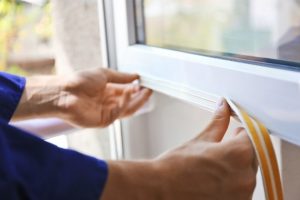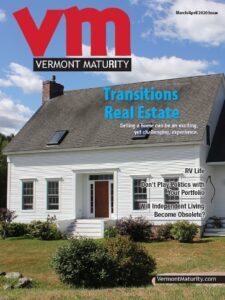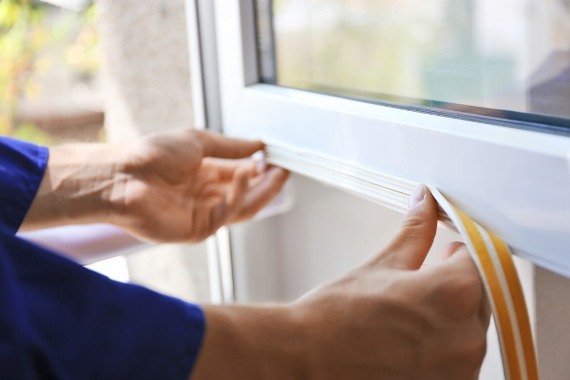Air infiltration — that’s what energy efficiency experts call those chilly drafts across the floor in the winter and the extra load of hot, humid air on the air conditioner in the summer. And it’s expensive. Here’s what to do to tighten your home before temperatures fall this year.
“The first thing to do is easy and free,” says energy efficiency expert Scott Hanauer. “Make sure your windows are shut during heating and cooling seasons. And locked. This is especially important with double-hung windows. The upper sash slides down, and you can’t see it behind the curtains or mini blinds. Locking creates tighter, better weatherstripping.”
 Second, caulk around windows and door trim boards, inside and outside, with an acrylic latex caulk, Hanauer says, and make sure weatherstripping around doors is tight. If you can see light around a closed door on a sunny day, he says, you need new or better weatherstripping between the door and frame.
Second, caulk around windows and door trim boards, inside and outside, with an acrylic latex caulk, Hanauer says, and make sure weatherstripping around doors is tight. If you can see light around a closed door on a sunny day, he says, you need new or better weatherstripping between the door and frame.
Builder Keith Moore provides weatherization services for homeowners and adds that gray, cracked rubber is another sign the weatherstripping should be replaced. “Over time, that rubber can turn hard,” Moore says.
After those initial steps, consider scheduling an energy audit by the local utility company or a private weatherization contractor. The audit should include a blower door test, which Hanauer likens to a large whole-house fan inside an adjustable frame. “It depressurizes the house, so air from the outside is sucked in through any openings,” he says. The test shows leaks in windows and doors, as well as exterior wall outlets and switches, plumbing chases, attic accesses, water spigots, electric lines, places where round pipes pass through square holes and more.
Then check your home’s insulation, particularly in the attic. “If you poke your head into the attic and you can see the floor joists, you don’t have enough. You should be able to see a sea of insulation,” Hanauer says.
Insulation is measured by R-value. The higher the R-value the less heat transfer there is in winter and summer. How much is enough varies by region, but in general, Hanauer says, more is better.
Moore agrees. “Adding insulation in the attic is where you’ll get the biggest bang for your buck,” he says. “That’s where most of your heat goes out. You can do it yourself with batt insulation, but hiring it done is still relatively inexpensive.”
The price will depend on the size of the house, roof pitch, attic access and any other special conditions. Even in the most complex situation, Moore says, the cost is only about $1 to $1.50 per square foot for materials and labor. “It’s not a huge expense,” he says.
Moore cautions not to put any insulation, whether batt or blown-in, over old knob and tube wiring. “This is a fire hazard,” he says.
Homeowners also may consider replacing loose windows and doors. “In some older homes, the doors are wood, the thresholds are wood and the weatherstripping is outdated, which allows air and bugs to come through,” Moore says. “We put in a new metal door with a hard plastic thermal break between the two metal sheets and metal weatherstripping with a neoprene seal between the door and jamb.”
For those evaluating replacement windows, Hanauer suggests casement windows, which crank out, rather than double-hung windows, which slide up and down. “Casements have a compression fit that creates less friction and wear on the weatherstripping and provide a tighter seal,” he says. Windows should be double- or triple-pane with a low-emission, or low-e, reflective coating.
However, Hanauer says, the decision to replace windows is more about personal preference than it is about saving money. “From a strict energy efficiency standpoint, it’s not a good investment,” he says. “It’s about a 20-year payback (in energy savings). But there are non-economic factors, such as ease of operability and cleaning, improved appearance and comfort.”
Don’t know where to start? “Start at the upper levels and work your way down,” Hanauer says. “That’s the most efficient way to control not just the draft blowing across your easy chair but all air infiltration and air stratification (having a hot upstairs and cold downstairs).”
But “don’t get obsessive trying to seal your house completely,” he adds. The entire volume of air in a home can be exchanged with fresh air every three to five hours and still be considered tight. Some new construction is so tight that the air becomes stale, and humidity buildup encourages mold growth.
“Do what you can, and don’t worry about what you can’t,” Hanauer says. Just closing those little holes and cracks is a big step in the right direction. “Homeowners can save as much as 20 percent in energy costs. And you’ll be more comfortable.”
For more information visit EnergyStar.gov.
This article was contributed by DiAnne Crown.
 Related Articles & Free Subscription
Related Articles & Free Subscription
Energy Efficiency Remodeling Saves Money…and the Environment
Harnessing the Power of the Sun






Comment here